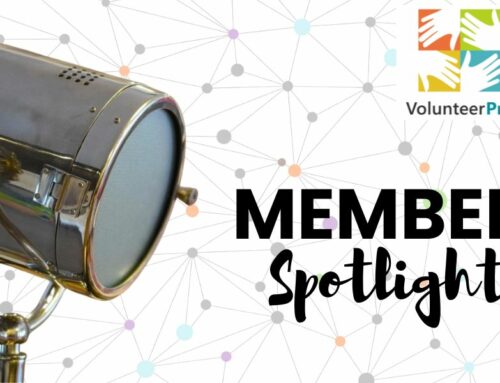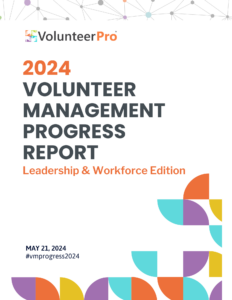One Simple Goal-Setting Strategy Busy Volunteer Managers Will Love
Over the past four weeks we’ve been sharing planning strategies and tools to help volunteer managers and volunteer coordinators get a jump start building their strategy.
In this mini-series for leaders of volunteers, we’ve shared how to map out your roles for volunteers and how to get your co-workers onboard. We’ve talked about ways to overcome procrastination and get started planing with a simple SPOT Matrix. We’ve written about how to align the goals of volunteer services with the goals of your entire organization. Finally, we’ve helped you tackle limiting mindsets and convert them into enabling thought patterns.
Now’s the time to hone all of that discovery down to one simple goal-setting strategy volunteer managers like you can use to explain your goals for the year, inspire buy-in, and enlist active participation.
The secret sauce to your success here is simplicity.
Not the mind-numbing 20-page strategy plans, with 30 pages of appendices. No, not those.
Rather, a simple two-page focused overview of what you will achieve together. Of course, this level of simplicity won’t work everywhere. You’ll likely need more detail in your project implementation plans.
But the the annual strategy you use to generate excitement and momentum should be focused, smart, and clear. The more people understand it, the more likely they’ll want to support it.
So what goes into such a goal-setting strategy? Read on!
Creating a Goal-Setting Strategy: SMARTER Goals
A BIG part of planning effectively is setting the right targets. After all, if you don’t know where you’re going, chances are you won’t get there.
By setting and communicating a set of specific stretch goals, your team will know what the priories are and what they will be accountable for. This helps your co-workers understand their role in your success and helps volunteers know where to focus their energies (and where to offer suggestions to bring about better results).
The SMART-ER acronym is a helpful way to remember what you should include when drafting goals and outcome indicators that will generate results. Evaluate each goal you set against the following criteria. Then, make adjustments to strengthen it.
Consider whether your goals are …
- Specific – Is the goal focused on one clear objective that all parties understand?
- Measurable – Are the results quantifiable and objectively verifiable?
- Attainable – Is the goal realistic? Are resources available to achieve it? Are people committed to it?
- Relevant – Does the goal offer relevant information to the process and its stakeholders?
- Time-bound – Is the goal attached to a time frame within which progress will be measured?
- Evaluated – Will the goal measure what it was supposed to measure? Is it a well-calibrated “stretch” goal?
- Re-evaluated – Do you have a plan to revisit the goal to ensure it still works in the current context and whether it’s still a priority?
How to Make it Concrete and Actionable
Here’s a quick formula for writing clear goals — By [deadline], [percentage or raw number] of [target population] will [anticipated change]. Simply plug in the missing information and you’ll have a pretty solid goal.
So, instead of …
75% of graduates who receive mentoring will find a job.
Use …
By June 30, 2016, 48 job readiness course graduates who were matched with a volunteer mentor will be placed in full-time jobs earning at least $15 per hour.
And, instead of …
At least 90% of volunteers will say they are happy with their experience.
Use …
At the close of their third month of involvement, 90% of volunteers will say that it is very or extremely likely they would recommend volunteering with our organization to friends and family.
When creating your goal-setting strategy for the year, most volunteer programs will do fine with no more than five to seven big goals. Again, keeping things simple will help you generate energy and enthusiasm. The fastest way to lose momentum is to overwhelm your team with an exhaustive laundry list.
So, choose carefully what you plan to achieve in partnership with your volunteer team. Many of your goals will likely coincide with the goals of the departments where volunteers serve, so coordinate with them to see where you overlap.
Also, check what your grants require. No one wants to scramble around when grant reporting time comes around. There will, no doubt, be a few practical goals you’ll need to include in your plan.
Don’t forget to also consider whether there is a program development or improvement goal you might include in the mix. If you don’t work both IN your program and ON your program, your engagement strategy is likely to stagnate.
Creating a Goal-Setting Strategy: Focus Your Goals Further
After you’ve created a list of goals, you will probably have too many. It happens. We’re an ambitious lot!
So, you will need to pare them down a bit. This is where you can really get strategic.
Of all the goals you can choose from — and of all the areas you can spend your energy — it’s smart to select those that will get you the best possible traction.
So, choose the goals where your hard work is more likely to pay off. If not in the short-term, in the longer-term.
How to Hone In on the Most Important Goals
Before you assess your list of goals, ask yourself the following questions. Then cross reference with your list of goals to see where there is resonance.
- How can our organization meet our mission more effectively by engaging volunteers?
- Where are our most critical program gaps?
- What problems do you need to solve that are blocking progress?
- What big events or changes are happening in your organization or community that you need to prepare for?
- What key milestones must we meet?
- Where could we achieve a significant breakthrough if we invested a little time and energy?
- What is already working that we should double down on?
- What could we add to something we already do that would make our results even more extraordinary?
- What are our competitors doing that we should be doing?
- What’s something people are doing in other industries that might work for us, too?
- What should we stop doing or eliminate because it’s wasting our time?
- What is realistically doable for us right now?
- What might be doable with more resources (time or money)?
- Who is eager to help us be successful?
This exercise will keep you from choosing your pet objectives over innovations that can really move you forward. It will also help you identify anything you’ve left out.
And, these questions may prompt others. So, don’t let the list above limit you. Keep asking and probing for ideas and answers!
At the same time, don’t let your answers result in scope creep. Refine your set of goals to no more than five to seven and your team will thank you!
Need a tool to help you keep it simple? Check out this week’s free download.
Level Up Your Volunteer Management Game Plan Mini Series
Over the past four weeks in the VolPro blog, we’ve shared a series of free downloads to help you get a jump on planning for 2019. Each week we release one (1, 2, 3, 4, 6) — be sure to collect all six!
This week, check out The (Deceptively) Simple 2-Page Plan for Volunteer Managers. This framework will help you create and communicate an easy plan for your audience to digest and generate excitement and momentum!






